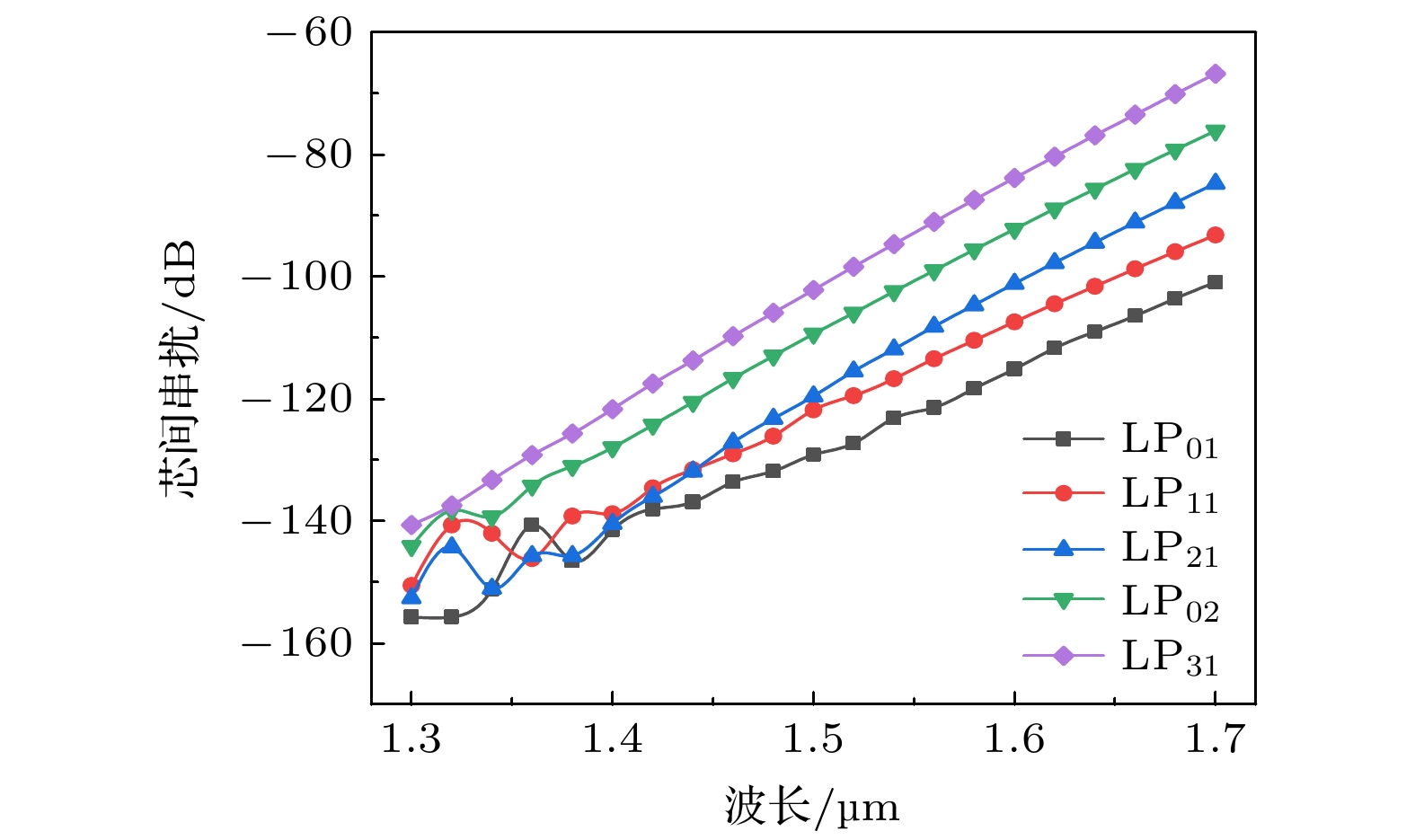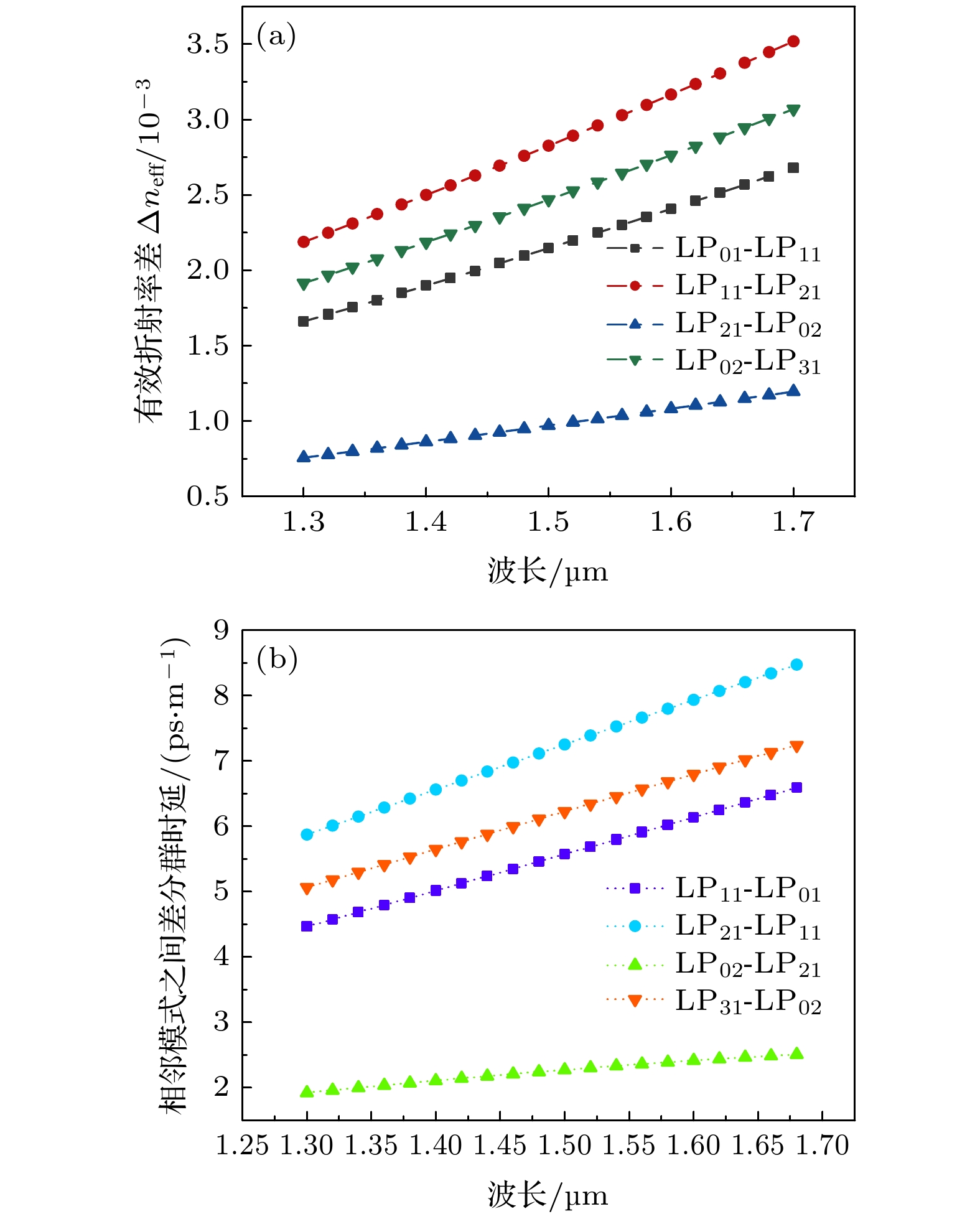-
信息化对高速大容量光纤网络的需求日益强烈, 空分/模分复用是继波分复用之后可使通信容量翻倍的新一代光纤通信技术. 本文提出了一种双沟槽环绕型十三芯五模光纤, 以满足未来对高速大容量信息传输的需求. 针对空分-模分复用中降低串扰的目标设计优化光纤, 采用双沟槽环绕结构, 将光能量更好地限制在纤芯内, 从而减小芯间和模间串扰. 利用全矢量有限元法与功率耦合理论相结合计算并分析多芯光纤的串扰和传输特性. 经过优化结构参数, 可使光纤在1.3—1.7 μm波段内稳定传输LP01, LP11, LP21, LP02, 和LP31 5个模式; 信号在1.55 μm波长处传输60 km时, 对应于以上5个模式相邻纤芯的芯间串扰分别为–122.37, –114.76, –106.28, –100.68, –92.81 dB, 相邻模式之间的有效折射率差大于1.026 × 10–3, 芯间和模间串扰可以被有效抑制; 5个模式对应的非线性系数分别为0.74, 0.82, 0.88, 1.26, 0.93 W–1·km–1, 均可保持低非线性传输. 该光纤结构简单紧凑, 可利用气相沉积法和堆叠法制备预制棒, 进一步拉制成具有低串扰低非线性的十三芯五模光纤, 可应用于长距离高速大容量光纤传输系统.Information technology has an increasingly strong demand for high-speed and large-capacity optical fiber networks. Space division multiplex(SDM) is a new generation of optical fiber communication technology which can be several times in communication capacity higher than the wavelength division multiplexing systems. In this paper, we present a kind of 13-core 5-mode fiber with double trench structure to meet the demand for high-speed and large-capacity information transmission in the future. In order to solve the crosstalk problem in SDM, a double-trench structure is adopted to better limit the light energy in the fiber core, thus reducing the crosstalk between cores and modes. The crosstalk and transmission characteristics of multi-core fiber are calculated and analyzed by the full vector finite element method and coupled power theory. After the optimization of structural parameters, the fiber can stably transmit LP01, LP11, LP21, LP02 and LP31 in the band of 1.3–1.7 μm; when the signal is transmitted at the 1.55 μm for 60 km, the inter-core crosstalks corresponding to the adjacent fiber cores in the above five modes are –122.37 dB, –114.76 dB, –106.28 dB, –100.68 dB and –92.813 dB, respectively; the effective refractive index difference between adjacent modes is greater than 1.026 × 10–3; inter-core and inter-mode crosstalk can be effectively suppressed. The corresponding non-linear coefficients of the 5-modes are 0.74 W–1·km–1, 0.82 W–1·km–1, 0.88 W–1·km–1, 1.26 W–1·km–1, 0.93 W–1·km–1, which can maintain low non-linear transmission. The structure of fiber is simple and compact, and the preform can be fabricated by vapor deposition method and stack method, then the 13-core five-mode fiber with low crosstalk and low nonlinear can be further drawn, which can be used in a long distance high-speed and large-capacity fiber transmission system.
-
Keywords:
- space division multiplex /
- a double-trench /
- low-crosstalk /
- low non-linearity
[1] 张伟, 陈鹤鸣 2017 光通信研究 4 26
 Google Scholar
Google Scholar
Zhang W, Chen H M 2017 Study on Optical Communications 4 26
 Google Scholar
Google Scholar
[2] Takenaga K, Arakawa Y, Tanigawa S, Guan N, Matsuo S, Saltoh K, Koshiba M 2011 IEICE Trans. Commun. E94B 409
 Google Scholar
Google Scholar
[3] Xie Y H, Pei L, Zheng J J, Zhao Q, Ning T, Li J 2020 Opt. Commun. 474 126155
 Google Scholar
Google Scholar
[4] Sakamoto T, Saitoh K, Saitoh S, Shibahara K, Wada M, Abe Y, Urushibara A, Takenaga K, Mizuno T, Matsui T, Aikawa K, Miyamoto Y, Nakajima K 2018 J. Lightwave Technol. 36 1226
 Google Scholar
Google Scholar
[5] Mori T, Sakamoto T, Wada M, Yamamoto T, Yamamoto F 2014 Optical Fiber Communications Conference and Exhibition (OFC) San Francisco, CA Mar. 09–13, 2014
[6] Kumar D, Ranjan R 2018 Opt. Fiber Technol. 41 95
 Google Scholar
Google Scholar
[7] Sasaki Y, Takenaga K, Matsuo S, Aikawa K, Saitoh K 2017 Opt. Fiber Technol. 35 19
 Google Scholar
Google Scholar
[8] 苑立波 2019 激光与光电子学进展 56 170612
 Google Scholar
Google Scholar
Yuan L B 2019 Laser. Opt. Pro. 56 170612
 Google Scholar
Google Scholar
[9] 涂佳静, 乔喜慧, 隆克平 2017 光子学报 46 0106001
 Google Scholar
Google Scholar
Tu J J, Qiao X H, Long K P 2017 Acta Photon. Sin. 46 0106001
 Google Scholar
Google Scholar
[10] 郑斯文 2014 博士学位论文 (北京: 北京交通大学)
Zheng S W 2014 Ph. D. Dissertation (Beijing: Beijing Jiaotong University) (in Chinese)
[11] Takenaga K, Arakawa Y, Tanigawa S, Guan N, Matsuo S, Saitoh K, Koshiba M 2011 Conference on Optical Fiber Communication (OFC) Los Angeles, CA Mar. 06–10, 2011
[12] Koshiba M, Saitoh K, Kokubun Y 2009 IEICE Electron. Express 6 98
 Google Scholar
Google Scholar
[13] Xia C, Amezcua-Correa R, Bai N, Antonio-Lopez E, Arrioja D M, Schulzgen A, Richardson M, Linares J, Montero C, Mateo E, Zhou X, Li G F 2012 IEEE Photonics Technol. Lett. 24 1914
 Google Scholar
Google Scholar
[14] 徐闵喃, 周桂耀, 陈成, 侯峙云, 夏长明, 周概, 刘宏展, 刘建涛, 张卫 2015 物理学报 64 234206
 Google Scholar
Google Scholar
Xu M N, Zhou G Y, Chen C, Hou Z Y, Xia C M, Zhou G, Liu H Z, Liu J T, Zhang W 2015 Acta Phys. Sin. 64 234206
 Google Scholar
Google Scholar
[15] 姜姗姗, 刘艳, 邢尔军 2015 物理学报 64 064212
 Google Scholar
Google Scholar
Jang S S, Liu Y, Xing E J, 2015 Acta Phys. Sin. 64 064212
 Google Scholar
Google Scholar
[16] 裴丽, 王建帅, 郑晶晶, 宁提纲, 解宇恒, 何倩, 李晶 2018 红外与激光工程 10 35
 Google Scholar
Google Scholar
Pei L, Wang J S, Zheng J J, Ning T G, Xie Y H, He Q, Li J 2018 Infrared and Laser Engineering 10 35
 Google Scholar
Google Scholar
[17] 曹原, 施伟华, 郁小松, 赵永利, 张杰 2017 光子学报 46 45
 Google Scholar
Google Scholar
Cao Y, Shi W H, Yu X S, Zhao Y L, Zhang J 2017 Acta Photon. Sin. 46 45
 Google Scholar
Google Scholar
[18] Gruner-Nielsen L, Sun Y, Nicholson J W, Jakobsen D, Jespersen KG, Lingle R, Palsdottir B 2012 J. Lightwave Technol. 30 3693
 Google Scholar
Google Scholar
[19] 赵佳佳 2018 博士学位论文 (武汉: 华中科技大学)
Zhao J J 2018 Ph. D. Dissertation (Wuhan: Huazhong University Science and Technology) (in Chinese)
[20] 刘俊彦 2015 硕士学位论文 (北京: 北京邮电大学)
Liu J Y 2015 M. S. Dissertation (Beijing: Beijing Youdian University) (in Chinese)
[21] Qiu J C, Liu H K, Tian X X 2008 Acta Photon. Sin. 37 297
[22] Wang W C, Sun C Y, Wang N, Jia H Z 2020 Opt. Commun. 471 125823
 Google Scholar
Google Scholar
[23] Takenaga K, Sasaki Y, Guan N, Matsuo S, Kasahara M, Saitoh K, Koshiba M 2012 2012 IEEE Photonics Society Summer Topical Meeting Series Seattle, WA, USA August 27 2012 p191
[24] Begum F, Namihira Y, Razzak SMA, Kaijage S, Miyagi K, Hai NH, Zou N 2007 Opt. Rev. 14 120
 Google Scholar
Google Scholar
[25] Liu M, Yang J, Zhu T 2015 JETP Letters 102 274
 Google Scholar
Google Scholar
[26] Wan X, Wang Z Q, Sun B, Zhang Z X 2020 Opt. Quantum Electron. 52 289
 Google Scholar
Google Scholar
-
图 7 在∆1 = 0.015, 波长1.55 μm处5个模式的串扰、Aeff和Δneff与芯区大小的关系 (a)芯区大小和串扰的关系; (b)芯区大小和Aeff的关系; (c)芯区大小和模式折射率差的关系
Fig. 7. The relationship between crosstalk, Aeff, Δneff of five modes and core size at 1.55 μm: (a) The relationship between core size and crosstalk; (b) the relationship between core size and Aeff; (c) the relationship between core size and Δneff.
图 8 在1.55 μm处5个模式的芯间串扰、Aeff和∆neff与芯区相对折射率差Δ1的关系 (a) Δ1和芯间串扰的关系; (b) Δ1和Aeff的关系; (c) Δ1和模式折射率差的关系
Fig. 8. . The relationship between crosstalk, Aeff, ∆neff of five modes and Δ1 at 1.55 μm: (a) The relationship between Δ1 and crosstalk; (b) The relationship between Δ1 and Aeff; (c) The relationship between Δ1 and ∆neff.
表 1 光纤初始参数
Table 1. The initial fiber parameters
a/μm b1/μm b2/μm c1/μm c2/μm Λ/μm R/μm Δ1 Δ2 6 2 2 5 4 42 100 0.017 –0.01 表 2 光纤优化参数
Table 2. The optimal fiber performance.
a/μm b1/μm b2/μm c1/μm c2/μm Λ/μm R/μm Δ1 Δ2 8 2 2 4 4 42 100 0.015 –0.008 表 3 5个LP模式的串扰、有效模面积和MDGD(LPmn–LP01)
Table 3. Estimated values of crosstalk, effective area and MDGD(LPmn–LP01) for 5-LP modes at 1.55 μm.
Modes Crosstalk/
(dB/60 km)Aeff /μm2 MDGD/
(ps·m–1)LP01 –122.37 147 0 LP11 –114.76 134 5.855 LP21 –106.28 125 13.452 LP02 –100.68 87 15.799 LP31 –92.81 118 22.314 -
[1] 张伟, 陈鹤鸣 2017 光通信研究 4 26
 Google Scholar
Google Scholar
Zhang W, Chen H M 2017 Study on Optical Communications 4 26
 Google Scholar
Google Scholar
[2] Takenaga K, Arakawa Y, Tanigawa S, Guan N, Matsuo S, Saltoh K, Koshiba M 2011 IEICE Trans. Commun. E94B 409
 Google Scholar
Google Scholar
[3] Xie Y H, Pei L, Zheng J J, Zhao Q, Ning T, Li J 2020 Opt. Commun. 474 126155
 Google Scholar
Google Scholar
[4] Sakamoto T, Saitoh K, Saitoh S, Shibahara K, Wada M, Abe Y, Urushibara A, Takenaga K, Mizuno T, Matsui T, Aikawa K, Miyamoto Y, Nakajima K 2018 J. Lightwave Technol. 36 1226
 Google Scholar
Google Scholar
[5] Mori T, Sakamoto T, Wada M, Yamamoto T, Yamamoto F 2014 Optical Fiber Communications Conference and Exhibition (OFC) San Francisco, CA Mar. 09–13, 2014
[6] Kumar D, Ranjan R 2018 Opt. Fiber Technol. 41 95
 Google Scholar
Google Scholar
[7] Sasaki Y, Takenaga K, Matsuo S, Aikawa K, Saitoh K 2017 Opt. Fiber Technol. 35 19
 Google Scholar
Google Scholar
[8] 苑立波 2019 激光与光电子学进展 56 170612
 Google Scholar
Google Scholar
Yuan L B 2019 Laser. Opt. Pro. 56 170612
 Google Scholar
Google Scholar
[9] 涂佳静, 乔喜慧, 隆克平 2017 光子学报 46 0106001
 Google Scholar
Google Scholar
Tu J J, Qiao X H, Long K P 2017 Acta Photon. Sin. 46 0106001
 Google Scholar
Google Scholar
[10] 郑斯文 2014 博士学位论文 (北京: 北京交通大学)
Zheng S W 2014 Ph. D. Dissertation (Beijing: Beijing Jiaotong University) (in Chinese)
[11] Takenaga K, Arakawa Y, Tanigawa S, Guan N, Matsuo S, Saitoh K, Koshiba M 2011 Conference on Optical Fiber Communication (OFC) Los Angeles, CA Mar. 06–10, 2011
[12] Koshiba M, Saitoh K, Kokubun Y 2009 IEICE Electron. Express 6 98
 Google Scholar
Google Scholar
[13] Xia C, Amezcua-Correa R, Bai N, Antonio-Lopez E, Arrioja D M, Schulzgen A, Richardson M, Linares J, Montero C, Mateo E, Zhou X, Li G F 2012 IEEE Photonics Technol. Lett. 24 1914
 Google Scholar
Google Scholar
[14] 徐闵喃, 周桂耀, 陈成, 侯峙云, 夏长明, 周概, 刘宏展, 刘建涛, 张卫 2015 物理学报 64 234206
 Google Scholar
Google Scholar
Xu M N, Zhou G Y, Chen C, Hou Z Y, Xia C M, Zhou G, Liu H Z, Liu J T, Zhang W 2015 Acta Phys. Sin. 64 234206
 Google Scholar
Google Scholar
[15] 姜姗姗, 刘艳, 邢尔军 2015 物理学报 64 064212
 Google Scholar
Google Scholar
Jang S S, Liu Y, Xing E J, 2015 Acta Phys. Sin. 64 064212
 Google Scholar
Google Scholar
[16] 裴丽, 王建帅, 郑晶晶, 宁提纲, 解宇恒, 何倩, 李晶 2018 红外与激光工程 10 35
 Google Scholar
Google Scholar
Pei L, Wang J S, Zheng J J, Ning T G, Xie Y H, He Q, Li J 2018 Infrared and Laser Engineering 10 35
 Google Scholar
Google Scholar
[17] 曹原, 施伟华, 郁小松, 赵永利, 张杰 2017 光子学报 46 45
 Google Scholar
Google Scholar
Cao Y, Shi W H, Yu X S, Zhao Y L, Zhang J 2017 Acta Photon. Sin. 46 45
 Google Scholar
Google Scholar
[18] Gruner-Nielsen L, Sun Y, Nicholson J W, Jakobsen D, Jespersen KG, Lingle R, Palsdottir B 2012 J. Lightwave Technol. 30 3693
 Google Scholar
Google Scholar
[19] 赵佳佳 2018 博士学位论文 (武汉: 华中科技大学)
Zhao J J 2018 Ph. D. Dissertation (Wuhan: Huazhong University Science and Technology) (in Chinese)
[20] 刘俊彦 2015 硕士学位论文 (北京: 北京邮电大学)
Liu J Y 2015 M. S. Dissertation (Beijing: Beijing Youdian University) (in Chinese)
[21] Qiu J C, Liu H K, Tian X X 2008 Acta Photon. Sin. 37 297
[22] Wang W C, Sun C Y, Wang N, Jia H Z 2020 Opt. Commun. 471 125823
 Google Scholar
Google Scholar
[23] Takenaga K, Sasaki Y, Guan N, Matsuo S, Kasahara M, Saitoh K, Koshiba M 2012 2012 IEEE Photonics Society Summer Topical Meeting Series Seattle, WA, USA August 27 2012 p191
[24] Begum F, Namihira Y, Razzak SMA, Kaijage S, Miyagi K, Hai NH, Zou N 2007 Opt. Rev. 14 120
 Google Scholar
Google Scholar
[25] Liu M, Yang J, Zhu T 2015 JETP Letters 102 274
 Google Scholar
Google Scholar
[26] Wan X, Wang Z Q, Sun B, Zhang Z X 2020 Opt. Quantum Electron. 52 289
 Google Scholar
Google Scholar
计量
- 文章访问数: 7654
- PDF下载量: 107
- 被引次数: 0














 下载:
下载:












